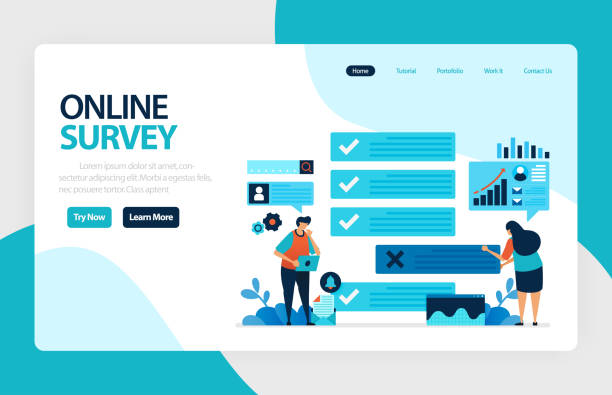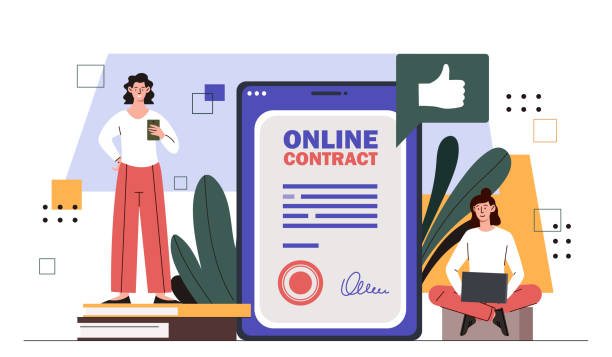Introduction to Responsive Website Design and its Necessity

In today’s digital world, where users navigate the web using various devices such as mobile phones, tablets, laptops, and even smartwatches, the concept of #Responsive_Website_Design or #Responsive_Web_Design has become vitally important.
This approach in #Web_Design allows websites to display optimally regardless of screen size or device type, providing a seamless user experience.
There is no longer a need for separate versions for mobile and desktop, which in itself is a significant educational and explanatory advancement in web development.
Before the advent of responsive website design, many websites were designed only for desktop displays, leading to an undesirable experience for mobile users.
Horizontal scrolling, frequent zooming, and difficult navigation were among the problems users faced.
With the increasing use of mobile for internet access, the necessity for a comprehensive solution was felt.
The World Wide Web Consortium (W3C) and leading developers introduced responsive website design as the golden standard for creating modern and user-friendly websites.
This approach means the website adapts to various screen dimensions, so that content, images, and element layouts dynamically reshape and are displayed to the user in the best possible way.
This is not just a trend, but a necessity for survival and success in the online space.
Do you dream of a thriving online store but don’t know where to start?
Rasaweb is your comprehensive e-commerce website design solution.
✅ Attractive and user-friendly design
✅ Increased sales and revenue⚡ Get free consultation
Why is Responsive Design a Competitive Advantage?

Adopting responsive website design is not merely a choice, but a vital strategy for any business that wants to remain competitive in the online space.
From an analytical perspective, responsive websites significantly help improve SEO rankings (Search Engine Optimization).
Google and other search engines prioritize websites that offer a good mobile user experience, which can directly lead to increased organic traffic and visits.
As a guide, investing in responsive website design not only enhances your brand’s credibility but also drastically reduces maintenance costs.
Instead of requiring two or more separate versions for different devices, a responsive website has only one codebase, making its management and updates much simpler and more cost-effective.
This is especially important for small and medium-sized businesses with limited budgets.
Furthermore, improved user experience leads to a lower Bounce Rate and longer user dwell time on the site, both of which are positive signals for search engine ranking algorithms.
Ultimately, increased customer satisfaction through a seamless and enjoyable user experience contributes to higher Conversion Rates and customer loyalty.
These tangible benefits have transformed responsive website design into a powerful competitive advantage.
Technical Components and Implementation of Responsive Design

Implementing responsive website design requires a deep understanding of specific technical principles and components.
One of these principles is the use of Fluid Grids, which use relative percentages instead of fixed pixels to define element widths.
This approach allows the website’s layout to flexibly adapt to the screen size.
The second key component is Flexible Images, which can adjust their size relative to their parent container using CSS, thus preventing images from being stretched or overly enlarged.
This section is considered part of the specialized and educational topics in web development.
But perhaps the most important tool in a responsive designer’s toolkit is Media Queries.
Media Queries allow developers to apply specific CSS rules based on device characteristics such as screen width, height, orientation (portrait or landscape), and even resolution.
This means that the layout, fonts, and even the display of certain elements can be completely changed for different devices.
The “Mobile-First” approach, where design is initially done for the smallest screen and then gradually expanded for larger screens, is also of high importance.
This approach ensures that the site functions well at any size and that necessary mobile optimizations are considered from the outset.
The table below provides a comparison of key approaches in responsive website design:
| Approach | Description | Advantages | Disadvantages |
|---|---|---|---|
| Fluid Grids | Using relative percentages (instead of pixels) for element widths | High flexibility, compatibility with any screen size | Requires precise calculations, may cause issues at very specific sizes |
| Flexible Images | Adjusting image sizes with CSS to fit the parent container | Prevents image distortion, optimizes loading | Requires attention to original image dimensions to prevent pixelation |
| Media Queries | Applying CSS rules based on device characteristics (width, height, orientation) | Precise control over layout at different Breakpoints | Increases complexity of CSS files, requires defining multiple breakpoints |
User Experience and SEO in Responsive Website Design

The relationship between User Experience (UX) and SEO in the context of responsive website design is very deep and reciprocal.
A responsive website naturally provides a better user experience; including better text readability, easier navigation, and faster loading times, especially on mobile devices.
These factors directly influence SEO metrics such as Bounce Rate and Dwell Time.
Users stay longer on a site that is easy to use, and this is a positive signal for search engines to recognize your website as useful and relevant.
This section is not only explanatory but also includes guidance for improving both aspects.
Google has explicitly stated that it prioritizes mobile-friendly websites in its mobile search results.
This means that if your website does not have responsive website design, it is likely to rank lower in mobile searches and lose valuable traffic.
Furthermore, a responsive website prevents duplicate content issues that previously arose from having separate mobile and desktop versions, making management and crawling by search engines simpler.
Optimizing images for loading speed, compressing code, and using caching are all actions that, alongside responsive website design, can significantly enhance your site’s SEO and UX.
This comprehensive approach ensures your strong online presence.
Did you know that 94% of users’ first impressions of a business are related to its website design? With professional corporate website design by **Rasaweb**, turn this initial impression into an opportunity for growth.
✅ Attract more customers and increase sales
✅ Build credibility and trust in the audience’s eyes⚡ Get a free website design consultation!
Challenges and Common Solutions in Responsive Design

Although responsive website design offers numerous advantages, its implementation is not without challenges.
One of the main questions developers face is how to maintain optimal site performance across different devices, especially on mobile phones with weak internet connections? Large images and heavy scripts can significantly increase loading times.
This is a key critical question that requires a solution.
Another challenge is maintaining consistent and optimal navigation and user experience across vastly different screen sizes.
How can complex menus be displayed user-friendly on small screens?
To overcome these challenges, there are several practical guidelines.
For performance optimization, using Responsive Images that load based on screen size, as well as compressing CSS and JavaScript files, is essential.
Implementing Lazy Loading for images and videos can also help reduce initial loading times.
Regarding navigation, using common mobile navigation patterns such as Hamburger Menus or bottom-of-the-page menus can improve the user experience.
Also, continuous testing across different devices and browsers is crucial to identify and resolve compatibility issues.
By adopting these approaches, the challenges of responsive website design can be turned into opportunities for improvement.
Tools and Frameworks for Responsive Design

To simplify the responsive website design development process, numerous tools and frameworks have been created that developers can utilize.
One of the most popular of these frameworks is Bootstrap, which offers a comprehensive set of HTML, CSS, and JavaScript tools for building responsive and mobile-first websites.
Frameworks like Foundation and Bulma are also powerful options that provide similar tools with slightly different design philosophies.
These tools are very useful for educational and specialized purposes and help accelerate the development process.
In addition to complete frameworks, new CSS features such as Flexbox and CSS Grid have revolutionized how responsive layouts are designed.
Flexbox is excellent for one-dimensional layouts (row or column) and easily allows for space distribution and item alignment.
CSS Grid is designed for two-dimensional layouts (rows and columns) and enables the creation of complex and flexible grids.
These capabilities give developers more power and control over responsive website layouts and reduce the need for hacks or additional JavaScript code.
Using Content Management Systems (CMS) like WordPress with responsive themes is also a simple way to create a responsive website without deep coding.
These tools have made responsive website design accessible to a wide range of developers, from beginners to professionals.
Future and New Trends in Responsive Design

The future of responsive website design extends beyond merely adapting to different screen sizes; this field is moving towards more immersive and intelligent user experiences.
One of the news-worthy and important trends is the emergence of Progressive Web Apps (PWAs), which combine the best features of web and native applications.
PWAs can work offline, send notifications, and even be added to the device’s home screen, while still maintaining their responsive nature.
This is a significant analytical advancement that changes how users interact with the web.
Other trends include the use of Artificial Intelligence (AI) in the design and development process, as well as an increased focus on Accessibility for all users.
Furthermore, designing for voice interactions and headless user interfaces (UI) is increasing, which creates new challenges for responsive website design.
With the advent of new devices like Augmented Reality (AR) and Virtual Reality (VR), the concept of “screen” is expanding, and designers must also optimize websites for these three-dimensional environments.
Web Scapes or web-based 3D experiences are examples of these developments.
These trends indicate that responsive website design is not a fixed concept, but an evolving field that continuously adapts to new technologies.
The table below points to some of these new trends:
| Trend | Brief Description | Impact on Responsive Design |
|---|---|---|
| Progressive Web Apps (PWAs) | Combining web and native app features, offline functionality, notifications | Increased engagement and reliability, better mobile user experience |
| AI in Design | Using AI to automate design and optimization processes | Accelerated responsive layout design, personalized suggestions |
| Web Scapes / 3D Experiences | Creating interactive 3D environments in web browsers | Expanding responsiveness to virtual and 3D dimensions, immersive experiences |
Successful Examples and Case Studies of Responsive Design

To better understand the impact and importance of responsive website design, looking at successful examples and real-world case studies can be very engaging and analytical.
Major companies such as Google, Apple, and Forbes have all designed their websites to be responsive for a long time.
These companies have reported significant improvements in user engagement metrics, including longer dwell times and reduced bounce rates, after implementing responsive design.
These results demonstrate the strategic value of this approach.
One prominent example is the Forbes website, which saw a significant increase in mobile visitors and improved SEO rankings after migrating to responsive website design.
This change not only enhanced the user experience but also helped Forbes maintain its competitive edge in a crowded media market.
Another example is The Washington Post website, which, with its responsive design, simplified access to content across various devices and consequently significantly increased user engagement.
These case studies clearly show that responsive website design is not just a trend but a proven strategy for online success.
This is especially crucial for media and content publishers with diverse audiences.
Do your e-commerce site visitors leave before making a purchase? Worry no more! With Rasaweb’s professional e-commerce website design services, permanently solve the problem of not converting visitors into customers!
✅ Significant increase in conversion rate and sales
✅ Unique and engaging user experience
⚡ Contact us now for a free consultation!
Cost-Benefit Analysis of Responsive Website Design

Investing in responsive website design may initially seem costly, but from an analytical perspective, its long-term benefits far outweigh the initial expenses.
Initial costs might include more development time and a need for higher expertise, but compared to creating and maintaining multiple separate websites (one for desktop, one for mobile, and perhaps one for tablet), a responsive website is much more cost-effective in the long run.
This section provides a deeper explanation of the Return on Investment (ROI) of this approach.
The need to maintain and update only one website drastically reduces the required resources and time.
In addition to maintenance cost savings, there are also indirect financial benefits.
Improved SEO rankings and enhanced user experience lead to increased organic traffic and, consequently, more sales and conversion opportunities.
A responsive site helps you reach a wider range of audiences without the need to develop and manage separate platforms.
Furthermore, enhancing brand image and professionalism in the eyes of customers is an intangible value that can lead to customer loyalty and increased future profitability.
Overall, responsive website design is not just an investment for the future but a smart business decision that yields significant returns.
This is an explanation for business managers who are weighing various aspects.
Conclusion and Final Recommendations for Responsive Website Design

In this article, we comprehensively reviewed responsive website design, from its fundamental principles and necessity to challenges, solutions, tools, and future trends.
It is clear that in the current era, having a website that is not responsively designed means losing a significant portion of the audience and falling behind competitors.
This is a definitive explanation of the importance of this technology.
Our final recommendation to all businesses and developers is to make responsive website design a cornerstone of their digital strategy.
This is not just a luxury feature, but an essential standard that improves user experience, boosts SEO rankings, and ultimately contributes to your business’s success.
By correctly implementing responsiveness principles and using appropriate tools, you can create a strong and sustainable online presence that meets the needs of users on any device.
This is a key guide to achieving your online goals.
The future of the web belongs to websites with high adaptability and flexibility, and responsive website design is the key to reaching this future.
Frequently Asked Questions
| Question | Answer |
|---|---|
| What is responsive website design? | It is an approach in web design that ensures a website displays correctly across various screen sizes (such as mobile, tablet, desktop) and its layout adapts to the user’s screen size. |
| Why is responsive design important? | Given the widespread use of different devices to access the internet, responsive design provides a consistent user experience for all users, reduces the website’s bounce rate, and improves the site’s SEO. |
| How is responsive design implemented? | This type of design is often implemented using CSS3 Media Queries, Flexible Grids, and Flexible Images. |
| What are the main components of responsive design? | It includes Media Queries for applying different styles based on device characteristics, using relative units (like percentages and ems) for sizes and layouts, and employing flexible images and media whose dimensions change to fit the available space. |
| What are the main advantages of using responsive design? | Improved user experience, reduced development and maintenance costs (compared to having separate versions for mobile and desktop), improved search engine ranking (as Google prefers it), and increased website accessibility for all users. |
And other services of Rasaweb Advertising Agency in the field of advertising:
Smart Sales Automation: A professional solution to increase click-through rates by focusing on real data.
Smart Marketplace: Revolutionize sales with personalized user experience.
Smart Content Strategy: A combination of creativity and technology to boost sales through the use of real data.
Smart Advertising Campaign: An innovative service to increase customer acquisition through marketing automation.
Smart Conversion Rate Optimization: A professional solution for customer acquisition focusing on precise audience targeting.
And over hundreds of other services in the field of internet advertising, advertising consultation, and organizational solutions.
Internet Advertising | Advertising Strategy | Advertorials
Resources
What is Responsive Design?
What is Responsive (Adaptive) Website Design?
What is User Experience (UX) Design?
Complete Training on Responsive Website Design
? Are you looking to advance your business in the digital world? Rasaweb Afarin, a leading digital marketing agency, with expertise in SEO, online advertising, and fast website design, paves your way to success.
📍 Tehran, Mirdamad Street, next to Bank Markazi, Kazeroon Janoubi Alley, Ramin Alley, No. 6



